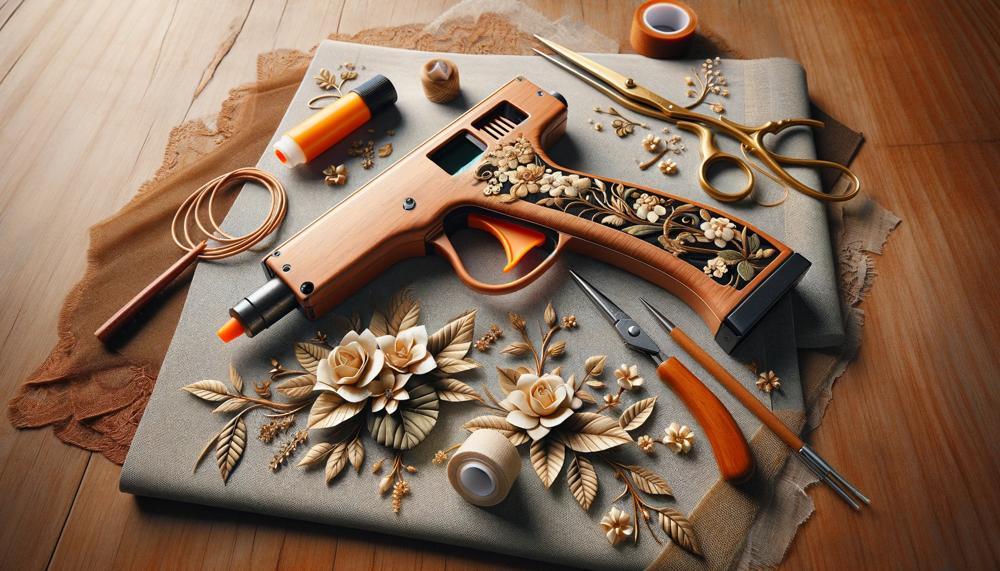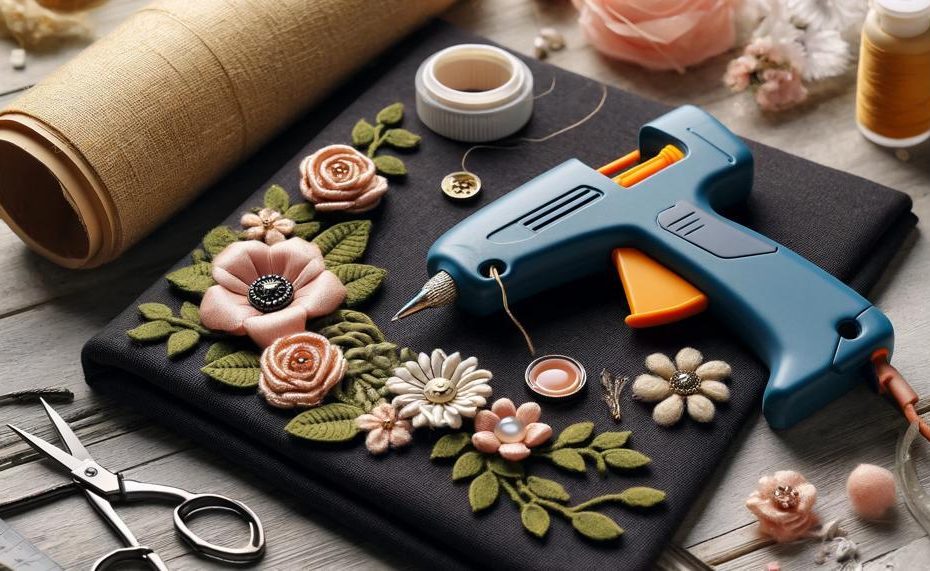Did you know that a low-temperature hot glue gun, set at just 260°F, can safely bond fabric without the risk of burns or damage? This startling fact might shift your perception of crafting possibilities, especially for those who dread the complications of traditional sewing.
In today’s DIY culture, the use of hot glue guns on fabric has emerged as a quick and efficient method to mend tears, attach embellishments, and even construct entire pieces of wearable art.
By employing the right tools and techniques, crafters can overcome the limitations of conventional fabric adhesives, unlocking new realms of creative expression.
Yes, you can use a hot glue gun on fabric, but there are a few things to keep in mind:
- Type of Fabric: Hot glue works well on fabrics like wool and cotton, which can handle the heat of the glue gun. However, for high-end fabrics such as silk, hot glue tends to leave a stain.
- Type of Glue: The type of glue stick you use matters. While generic glue sticks can work, they may not be ideal for fabric, especially if the fabric needs to withstand washing. Brands like Surebonder and Singer offer decent fabric glue sticks.
- Application: Make sure the fabric surface is clean and free of debris. Apply the hot glue to the desired location on the fabric and hold it in place until the adhesive cools and sets. Use a low setting on the hot glue gun to avoid scorching the fabric.
- Durability: Hot glue is not a long-term solution for fabric repairs. It’s not waterproof, which means that your fabric-based creations must either never go for a wash or have to suffer little to no damage when you decide to revert everything to its original state.
Remember, hot glue is a quick fix and may not be suitable for all fabric types or for long-term fabric repairs. If you’re unsure, it might be best to test the hot glue on a small, inconspicuous area of the fabric first.
Join us as we explore how to harness the power of hot glue for your fabric projects, ensuring both creativity and practicality in your crafting endeavors.
Table of Contents
Do Glue Sticks Matter?
Absolutely, glue sticks do matter, particularly when it comes to tasks requiring precise, clean adhesion with minimal mess. Different types of glue sticks are formulated for specific materials and purposes, affecting their efficiency and suitability for various projects, including fabric.
Types of Glue Sticks and Their Effects on Fabric Adhesion:
| Type | Description | Effect on Fabric |
| Regular Glue Sticks | Commonly used for paper and light crafting. Water-based, non-toxic. | Minimal adhesion; tends to peel off or wash out easily. Not ideal for durable fabric bonds. |
| High-Temperature Hot Glue | Stronger bond, suitable for heavier materials like wood and thick textiles. | Can bond fabric effectively but may damage sensitive fabrics with high heat exposure. |
| Low-Temperature Hot Glue | Designed for delicate materials, lower heat to prevent damage. | Safe for most fabrics without ruining texture or appearance; good for light to medium weight fabrics. |
| Fabric-Specific Glue Sticks | Formulated exclusively for fabrics, flexible and often washable. | Best for fabric as it provides a durable bond without stiffness, can withstand washes. |
Wool
A hot glue gun can indeed be used on wool fabric, but there are a few essential considerations to ensure the integrity of the fabric and the effectiveness of the bond. Wool, with its thick, textured fibres, requires careful handling when applying hot glue.
Below is a detailed guide on how to successfully use a hot glue gun on wool fabric, supported by pertinent research findings.
Step-by-Step Guide to Using Hot Glue on Wool
- Preparation: Heat the glue gun to the appropriate temperature. For wool, a lower temperature setting is preferred.
- Application: Apply a thin layer of glue to the area. Avoid over-application as this can lead to a bulky feel and might seep through the fabric.
- Bonding: Press the two pieces of wool together firmly until the glue sets. This usually takes a few seconds.
Pros and Cons
Pros:
- Speed: Hot gluing is much faster than sewing, ideal for quick repairs or projects.
- Ease of Use: Simple and straightforward, even for beginners.
Cons:
- Strength of Bond: While convenient, the bond may not be as strong or durable as sewn stitches, especially for garments under tension.
- Aesthetics: Can be bulkier and less neat compared to sewing.
Table of Do’s and Don’ts
| Do’s | Don’ts |
| Use a low-temperature setting. | Use a high temperature that might burn or shrink the wool. |
| Apply glue sparingly to avoid seepage. | Apply excessive glue leading to bulky and stiff sections. |
| Test on a scrap piece first. | Skip testing and potentially ruin the material. |
Cotton
Cotton, a robust and versatile material, generally withstands the heat of a glue gun well, making it suitable for such applications. However, this suitability varies based on the type and quality of the cotton fabric involved.
Pure cotton handles the heat better than poly-cotton blends, which may melt under the glue gun’s high temperatures. For delicate cotton fabrics, it’s wise to apply the hot glue indirectly to avoid potential damage. Here’s a detailed breakdown:
| Fabric Type | Heat Tolerance | Recommended Use |
| Pure Cotton | High | Direct application possible |
| Poly-Cotton Blend | Low | Indirect application recommended |
| Thin Cotton | Medium | Apply glue to applique, not directly on fabric |
It’s essential to consider the fabric’s response to heat before proceeding. If you’re using a pure cotton fabric, it behaves similarly to wool when interacting with a hot glue gun; it can be used safely.
For best practices, applying the glue to the applique instead of directly onto thin or sensitive cotton fabrics helps minimize any risk of heat damage. This approach not only preserves the integrity of the fabric but also ensures a safer crafting process.
Linen
Linen can indeed be a suitable fabric for using a hot glue gun, under certain conditions. The key factor here is the temperature of the glue gun. Linen, known for its durability and heat resistance, can withstand moderate temperatures.
Therefore, a low-temperature hot glue gun, which typically operates around 260°F, is recommended to prevent any scorching or weakening of the linen fabric.
Here’s a detailed analysis for using a hot glue gun on linen:
- Temperature Tolerance: Linen can handle up to 260°F, the common operating temperature for low-temperature glue guns. This makes it a viable option for projects that require quick bonding without long-term wear considerations.
- Application Technique: Apply a thin line of hot glue directly onto the linen. Press the two pieces together quickly for a strong bond. This method is especially effective for crafting and temporary fixes.
- Considerations for Durability: While hot glue provides an immediate hold, it is not always the most durable solution for fabrics that will be subject to frequent movement or washing. Linen, often used in garments and home textiles, might therefore require additional stitching or another form of reinforcement over time.
- Sewing: The most reliable method for attaching items to silk is by hand or machine sewing. This method does not involve heat and offers a durable finish.
- Fabric Glue: Specialized fabric glues designed for delicate fabrics like silk provide a good bond without the need for heat. These are often washable and flexible.
For a visual representation of how to apply hot glue to linen, refer to the table below:
| Step | Action | Tip |
| 1 | Choose the correct glue gun | Opt for a low-temperature model to avoid fabric damage. |
| 2 | Apply glue | Use a thin line along the edge or on one side of the linen. |
| 3 | Press and hold | Quickly align and press the other piece of linen on top, holding it for a few seconds to ensure a strong bond. |
So, linen is indeed a suitable fabric for projects involving a hot glue gun, provided the correct tools and methods are used to preserve the integrity of the fabric.
Silk
No, using a hot glue gun on silk fabric is not advisable as it can cause damage. Silk, due to its delicate nature and composition, is particularly susceptible to heat. Below is an analysis of why a hot glue gun might not be the best choice for silk and some alternative methods that could be used for adhering materials to silk fabric.
Silk is composed of protein fibers that react poorly to high temperatures, which can cause the fabric to scorch, melt, or distort. The heat from a hot glue gun is typically enough to trigger these adverse effects. Although hot melt glues are versatile and useful for quick fixes on many materials, they pose a significant risk when used on silk.
Alternative Methods:

Detailed Analysis in Table Format:
| Method | Suitability for Silk | Notes |
| Hot Glue Gun | Not Suitable | High heat can scorch, melt, or distort silk fibers. |
| Sewing | Suitable | Does not involve heat, preserves fabric integrity. |
| Fabric Glue | Suitable | Provides a safe adhesive alternative without damaging heat. |
While hot glue guns are practical for many materials, their application on silk should be avoided to preserve the quality and appearance of the fabric.
Viscose/rayon
Viscose, also known as rayon, is a semi-synthetic fabric renowned for its silk-like smoothness and cotton-like comfort.
It’s crafted from organic materials, primarily wood pulp, which undergoes a chemical transformation into a viscous solution before being regenerated into fibrous solid. This process endows the fabric with remarkable properties such as softness, breathability, and excellent dye absorption, making it highly versatile.
Why is viscose commonly used in fabric? The main draw of viscose lies in its adaptability and cost-effectiveness. It mimics the luxurious feel of silk and the comfort of cotton at a fraction of the price, making it a popular choice for a wide array of garments, from everyday attire like shirts and dresses to more specialized items like shawls and scarves.
Furthermore, viscose blends seamlessly with other fibers, enhancing fabric durability and texture, which broadens its application in both fashion and household products.
Table of Industrial and Domestic Uses of Viscose/Rayon:
| Use | Benefit | Example Products |
| Fashion | Soft, breathable, affordable | Dresses, shirts, scarves |
| Household Items | Highly absorbent, sturdy | Towels, tablecloths |
| Industrial Applications | Durable, elastic | Tires, automotive belts |
Viscose’s widespread use is also attributed to its strength and elasticity, which are essential qualities in industrial products like tires and automotive belts. The diversity of its applications, combined with its textile-friendly characteristics, firmly establishes viscose as a staple in both wardrobe and commercial uses.
Its sustainable aspect, deriving from renewable sources, also contributes to its popularity, although the manufacturing process does raise some environmental concerns due to the chemicals involved.
Polyester, poly-blends, nylon, etc.
When considering the types of fabric suitable for use with a hot glue gun, it’s pivotal to assess both the fabric’s resistance to heat and its texture. Based on research, certain fabrics like polyester, poly-blends, and nylon can endure the heat from low-temperature hot glue guns effectively.
These materials are robust enough to withstand temperatures around 260°F, which is the optimal heat setting for minimizing damage while ensuring a strong bond.
Suitability of Various Fabrics for Hot Glue Application
| Fabric Type | Hot Glue Suitability | Comments |
| Polyester | Yes | Resistant to moderate heat; maintains bond strength well. |
| Poly-blends | Yes | Blends often enhance the heat tolerance of the fabric. |
| Nylon | Yes | Good heat resistance; glue adheres without significant fabric damage. |
| Silk | No | High-end, delicate fabric; prone to staining and heat damage. |
| Felt | Yes | Thick texture ideal for strong adhesion with hot glue. |
Key Considerations When Using Hot Glue on Fabric:
- Heat Sensitivity: Always opt for a low-temperature hot glue gun when working with sensitive materials to avoid heat damage.
- Texture Suitability: Fabrics with a thicker, more robust texture like felt and heavy poly-blends tend to handle hot glue better.
- Application Purpose: Consider whether the glue is for a temporary fix or a permanent bond. Hot glue is not a substitute for sewing in long-term applications.
This approach ensures that you select the most appropriate fabric for your project, enhancing both the durability and aesthetics of the finished item.
Alternatives
| Type of Glue | Best For | Notes |
| PVA Glue | General fabric projects, especially cotton and linen | Water-based and non-toxic, easy to clean up, but slower drying time |
| Sewing Glue | Detail work and temporary positioning before sewing | Clear drying, washable, and doesn’t gum up sewing needles |
| Contact Cement | Leather, laminates, and other non-porous fabrics | Waterproof and highly durable, requires precise application |
| Epoxy | Heavy fabrics and mixed media (fabric to metal or plastic) | Forms a very strong bond, sets quickly, but can be messy |
| Super Glue | Small repairs and quick fixes on synthetic fabrics | Instant bond, but not flexible and may discolor fabric |
| Adhesive Dots | Embellishments, trim, or in scrapbooking | Easy to use, no mess, but not suitable for heavy materials |
| Tacky Glue | Craft projects with fabric, felt, and decoration | Thicker than PVA, dries clear, offers a strong hold |
| Double-Sided Tape | Quick hems, trims, and temporary placement | No drying time required, provides a clean finish |
Choosing the right adhesive for fabric projects depends significantly on the type of material and the nature of the project. While a hot glue gun is quick and effective for many tasks, alternatives like PVA glue and sewing glue provide a gentler touch for delicate fabrics, avoiding the scorching heat that can damage sensitive textiles.
For sturdy, enduring bonds, especially on less porous surfaces, epoxy and contact cement are robust choices.
For crafters seeking a clean finish without the fuss of liquid adhesives, adhesive dots and double-sided tape offer precision and ease of use, perfect for lighter materials and decorative details.
Conclusion
In the world of fabric crafts, learn how low-temperature hot glue guns can change everything. This tool is not only a must-have in the wide world of fabric arts, but it is also a revolutionary tool that lets you be creative while keeping the delicate essence of your materials. Dive into the possibilities, from fixing tears to adding details to works of art, all while keeping the beauty and purity of your fabrics.
This guide stresses how important it is to match the right sticky properties to the properties of your fabric, from picking the best glue type to learning how to use it in specific situations. Whether you’re working with strong cotton or delicate silk, picking the right low-temperature glue gun can make all the difference in the world. It will let you complete your projects with accuracy and style.
Not only learn how to use hot glue on fabrics, but also get good at it. To improve your creating skills, learn the differences between temperature settings and types of glue sticks. Enjoy the speed and ease of hot glue, along with the sturdiness that sewing offers. Your cloth projects will not only turn out great, but they will also last for a long time if you use the right techniques and choose the right materials.
Take on each job as a chance to combine usefulness with creativity.






